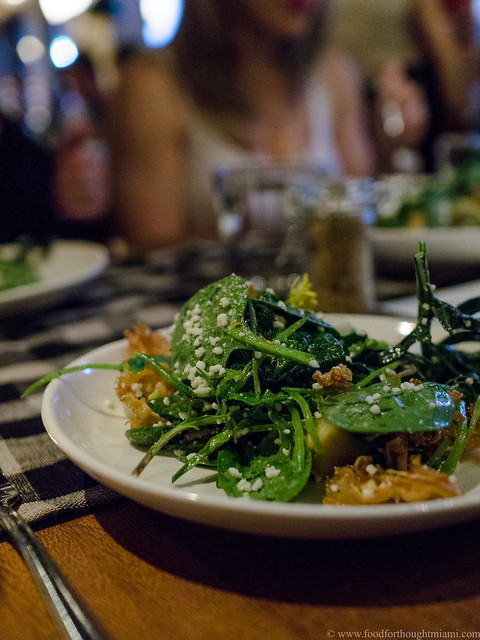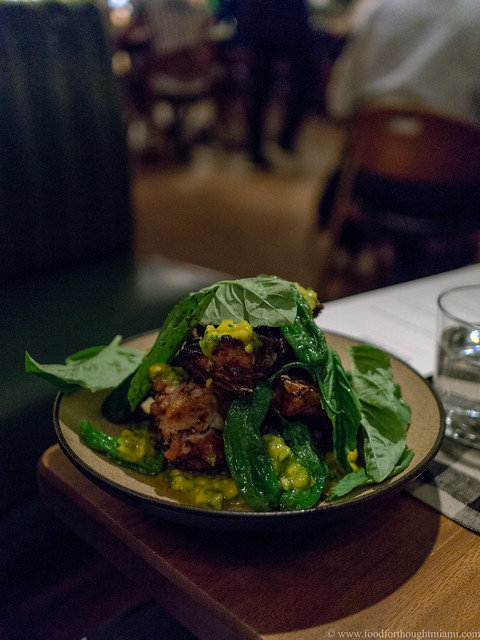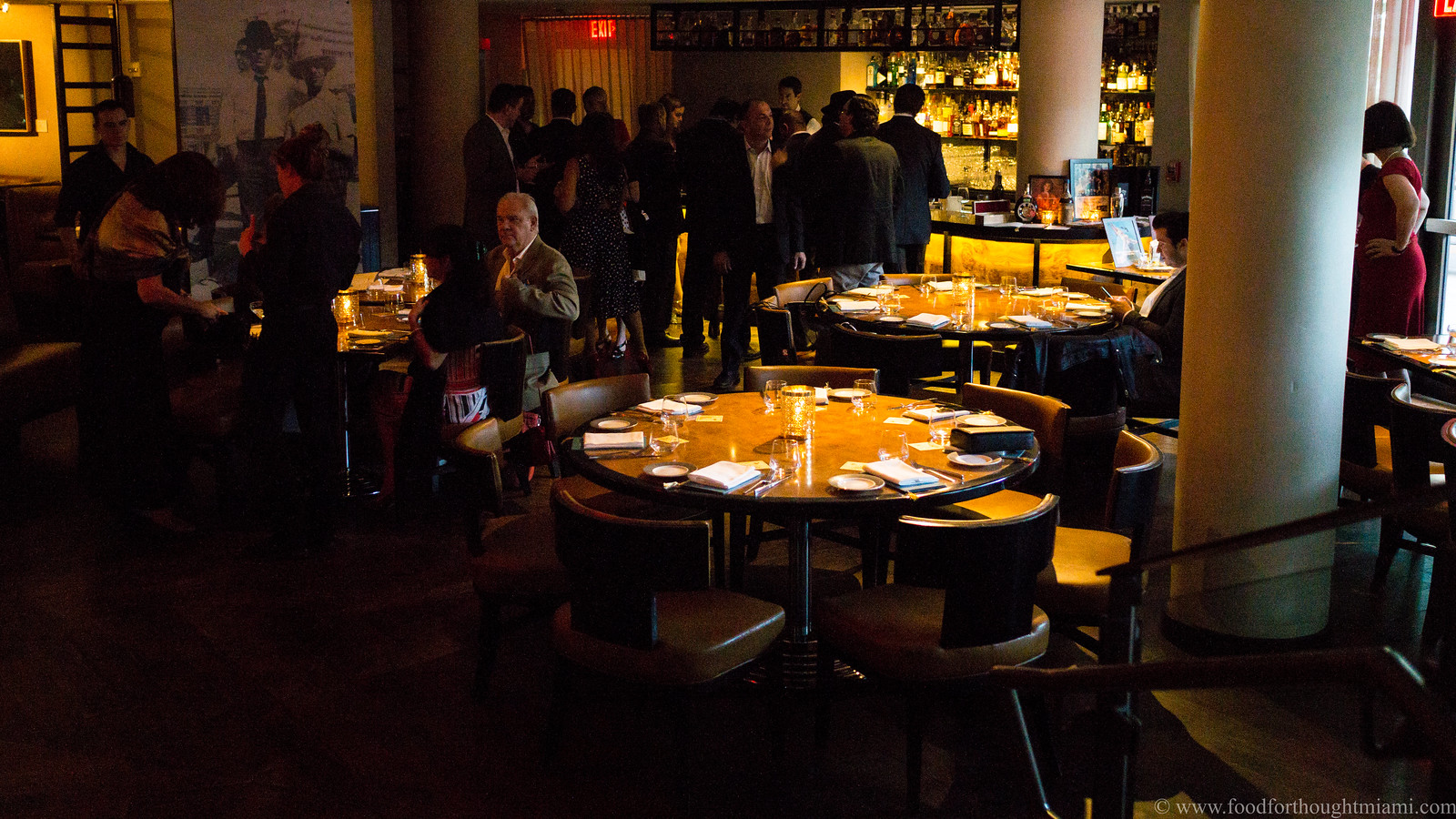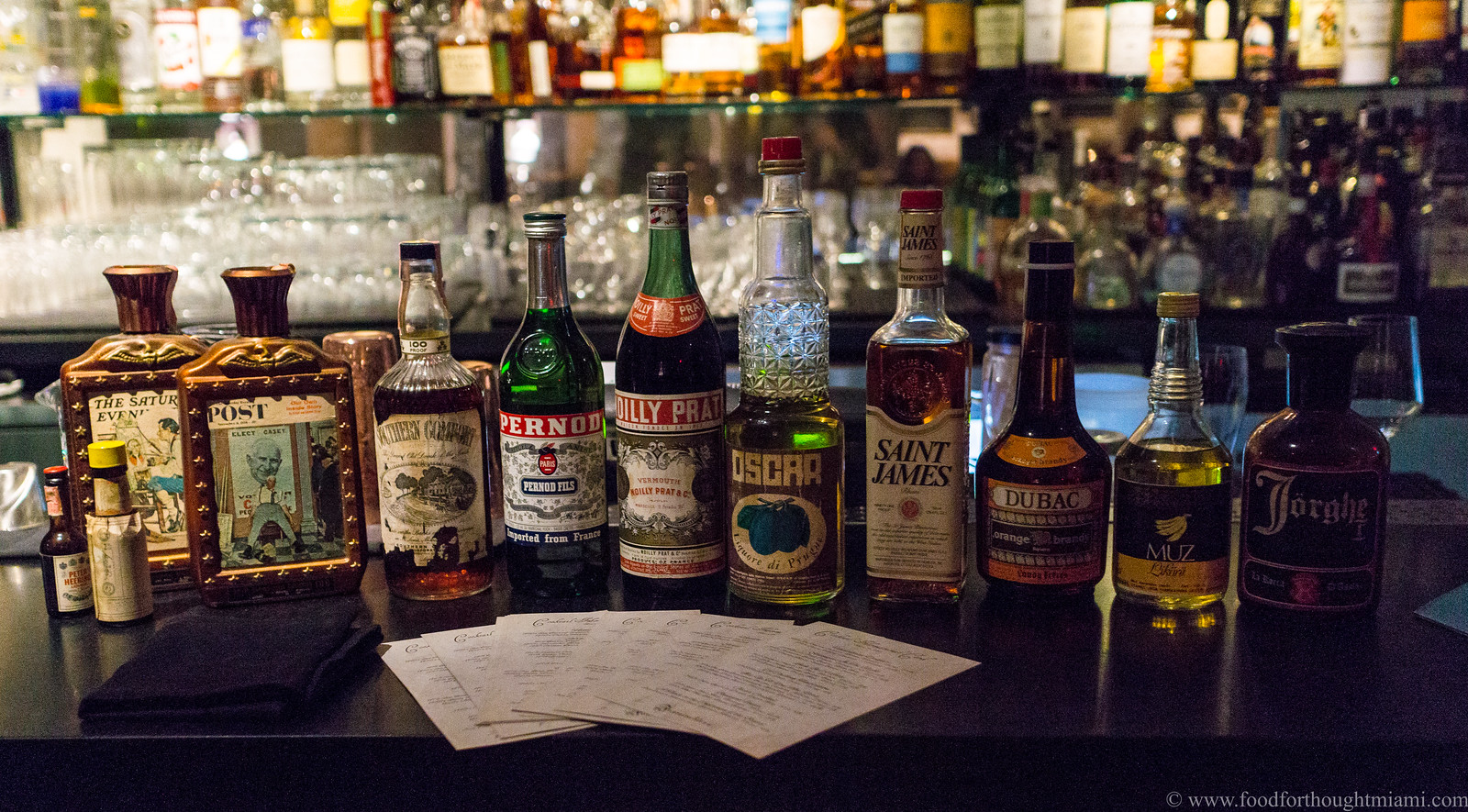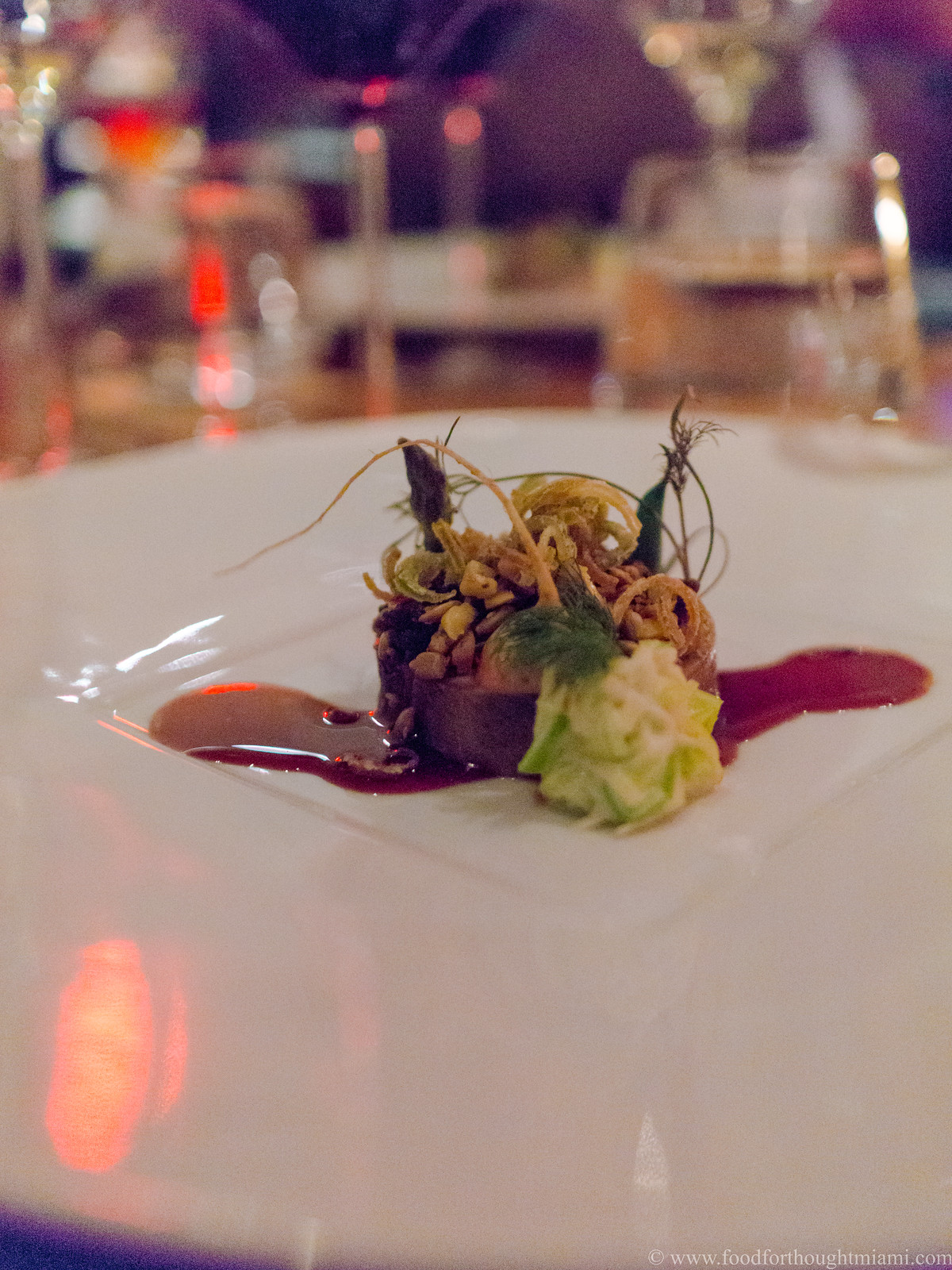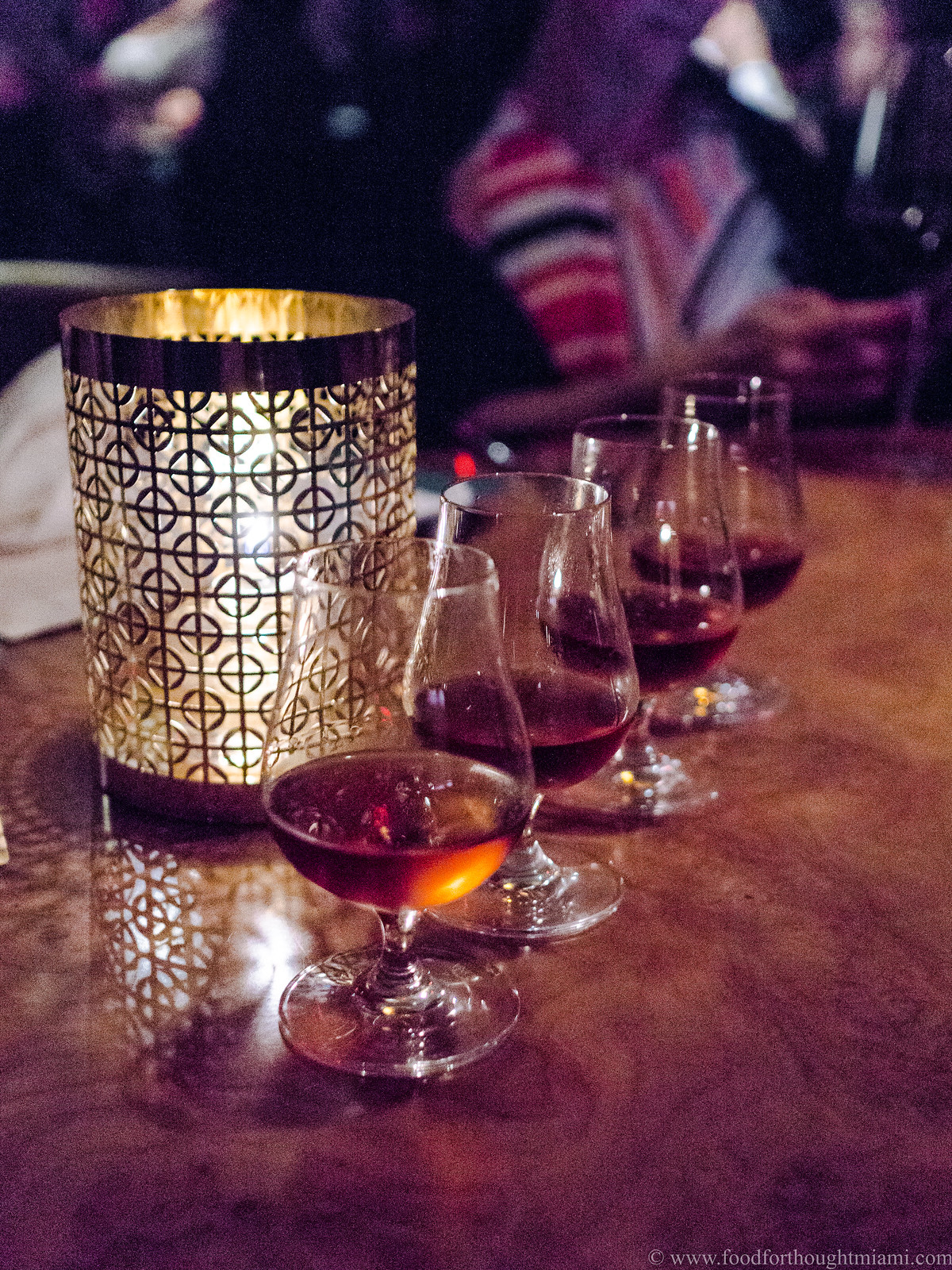Wednesday, April 4, 2018
Cobaya Upland with Justin Smillie
When I first heard that Upland was opening in Miami Beach, the place was something of an enigma to me. I thought of Justin Smillie as a New York City chef (one whose NYC restaurant, also named Upland, I'd never tried), but the menu felt like it came from the other coast. As it turns out, Upland is a town in San Bernardino County inland of Los Angeles where Smillie was born, and his cooking style is indeed very much inspired by the "California cuisine" idiom: seasonal, vegetable forward, casual in presentation but still precise in execution.
The South of Fifth spot, which Smillie opened with restaurateur Stephen Starr (whose Miami products also include Makoto and Le Zoo) has become one of my favorites among the latest crop of "Sixth Borough" restaurants in Miami. I love the dining room, designed by Roman & Williams, with its green leather banquettes and walls lined with backlit jars of preserved lemons. But even more, I love the food, whose superficial simplicity usually belies a sonorous depth of flavor.
We were eager to do a Cobaya dinner with him, and the interest was mutual, but since Smillie is not in South Florida regularly this was a challenging one to schedule. We finally lined up a date, and even though it was only a week after our last event, we jumped on the opportunity.
As always, our request to the chef was simple: do whatever you want, just don't do anything on your regular menu. Smillie's response was entirely off-menu, but also entirely in keeping with the spirit of his restaurant.[1] Here's what he made:
(You can see all my pictures in this Cobaya Upland with Chef Justin Smillie flickr set).
Smillie started things off with a salad – served family style – and my immediate reaction was, "It's not going to be as good as his little gem salad," a combination of perky gem lettuce, avocado, cucumber, and shaved ricotta salata in a walnut vinaigrette that hits all the right notes for me. I was wrong. This was every bit its equal. Here were all sorts of early spring things: tender spinach leaves, asparagus, fava beans, artichokes, frilly little mushrooms that were crispy like croutons. Crumbled cotija cheese added some creamy richness, a precisely balanced vinaigrette added structure and brightness.
Mrs. F thinks I hate salads. I don't. A good salad makes me very happy, and this was a very good salad.[2]
Spring is also the season for soft shell crabs, when they molt from their hard exoskeletons and basically the whole critter can be eaten. Smillie gave these a crispy new shell of flaked coconut, and served them with a hemp seed aioli and a bouquet of fresh soft herbs. There was a sneaky bit of nostalgia here which it took me a while to pinpoint: this was like a gussied up version of coconut shrimp!
Speaking of nostalgia – when was the last time you had mango salsa? When was the last time you actually saw mango salsa on a menu, even here in the erstwhile capital of Mango Salsaville? Smillie described this dish as "hot smoked tuna cheek, spicy mango," but let's call that "spicy mango" what it is: MANGO SALSA! And it was delicious! The smoked tuna cheek, like the Japanese izakaya staple hamachi kama (yellowtail collar), was somewhat fiddly and took some work to extract the good bits, but the reward was some of the fattiest, most unctuous, flavorful flesh on the fish. And yes, it tasted great with the sweet and heat of that "spicy mango," as well as the blistered shishito peppers and huge basil leaves draped on top.
If the Miami Heat can break out some neon pink and blue Miami Vice uniforms this year, it's only fitting we bring back mango salsa too.
(continued ...)
Sunday, March 25, 2018
Cobaya Time Machine at Stripsteak with William Crandall and Seth Weinberg
There were no paintings of poodles, but just about everything else from our Cobaya dinner at Stripsteak a couple weeks ago hearkened back to the era of the Poodle Room, a cozy bar from the opening days of the Fontainebleau resort. Designed by architect Morris Lapidus and completed in 1954, the Fontainebleau was maybe the most ostentatious example of the grand but playful "Miami Modern" style, and quickly became a popular playground for the rich and famous. Frank Sinatra and the "Rat Pack" hung out here. Elvis performed here after he returned from military service. Movies were filmed here, including Jerry Lewis' "The Bellboy" and scenes from "Goldfinger" My in-laws (neither rich nor famous, but long-time Miami Beach denizens) used to go see shows at La Ronde nightclub."Abandon care and enter light-hearted ...for this is the Poodle Room, the exquisite tongue-in-cheek room,and here life is never quite serious! Lift your cocktailsin an atmosphere reminiscent of an intimate salon in a French palace ...its damask decor a background for paintings of poodleswith an amusing resemblance to Fragonard's playful courtiers and ladies."
With all that history to play with, Stripsteak chef William Crandall and bar director Seth Weinberg went with a "Time Machine" theme for our dinner. They found postcards, matchbooks and swizzle sticks from the hotel's first days, scoured old menus for historical dishes, and maybe most remarkably, sourced spirits all from the 1950's through 1970's for cocktail pairings to go with the dinner. It was a pretty remarkable and fully realized experience.
You can see all my pictures in this Cobaya Fontainebleau 1954 flickr set. Here's a rundown of the evening.
Once our guests arrived, they were offered a Hemingway Daiquiri made with 1970's era Bacardi Superior rum and 1950's era Cherry Heering, along with grapefruit juice and lime. Then they were shown downstairs to the "Poodle Room" – a corner of the Stripsteak dining room conveniently situated next to the bar.
That bar counter was lined with spirits that were anywhere between forty and sixty years old, some recognizable – Southern Comfort, Pernod, Noilly Prat Vermouth – and some rather mysterious – Oscar Liquore di Prugne?
Chef Crandall had dug through old menus from the Fontainebleau to look for inspiration, and his lineup featured dishes that you very well may have eaten at the hotel's restaurants way back when, but prepared with modern cooking sensibilities. A disk of creamy, rich foie gras torchon came dappled with a peppered port wine sauce and a quenelle of soft, melted julienned leeks, very old school, but also a crispy pumpernickel crumble in place of the traditional toast points. With this, Seth poured something he called "Strangers in the Night," a sweet-leaning concoction of Barres Colheito Porto from 1979, 1950's Stravecchio Branca (an oak-aged Italian brandy), and 1957 Chateau Thierry orange bitters.
I thought it was smart that they didn't quite try to serve each cocktail with a particular dish, but instead would often serve them between courses, as the strong flavors could easily overwhelm more delicate dishes. This was especially so because Seth took his "Time Machine" mission pretty literally: than the citrus in the opening daiquiri, literally everything in the other cocktails came from another era. This made for some very spirit-forward drinks, which is how I usually like them, but can be a tough match with food. For the next round, and sticking with the Sinatra theme, there was a drink he called "Luck Be a Lady" –1962 Southern Comfort (higher proof and less sweet than the current version), 1972 Dubac Orange Brandy, and 1974 Jorghe Amaro, which brought a potently herbaceous, almost medicinal kick.
This is the kind of dish you never see any more: sole bonne femme, the traditional mushroom accompaniment taking the form of a fluffy wild mushroom mousseline as well as some shingles of black truffle, plus some confit shallots on top and a caviar speckled hollandaise alongside. Back in the day, sole would often be fileted and served tableside; we could have used some of that tableside service, or at least a heads-up that the fish was being served bone-in, as I got a mouthful of bones before realizing it. And the fish possibly could have cooked a bit more, to pull more cleanly away from the bone. But I thought the flavors here were a worthy take on the classic.
(continued ...)
Sunday, February 4, 2018
first thoughts: Shelley's | South Miami
 |
| Sorry We Missed You |
She's kind of hard to describe. (You can see all my pictures in this Shelley's - South Miami flickr set).
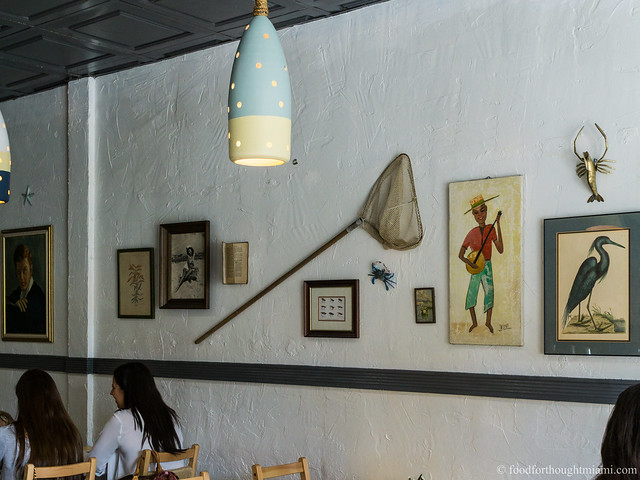 |
| Shelley's - dining room |
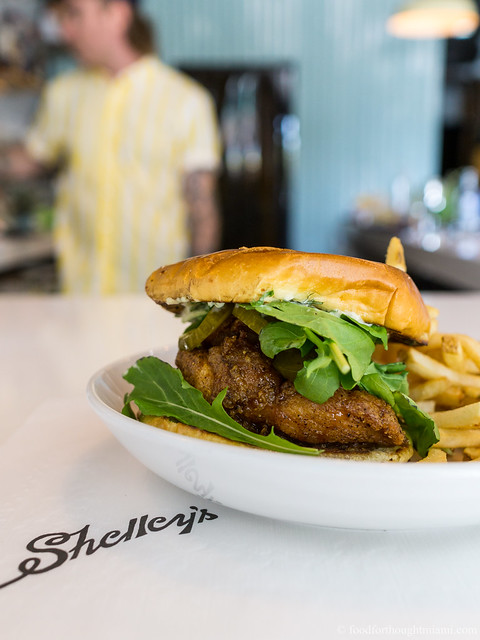 |
| fried chicken sandwich |
 |
| shrimp Scotch egg, grits, kimchi collard greens |
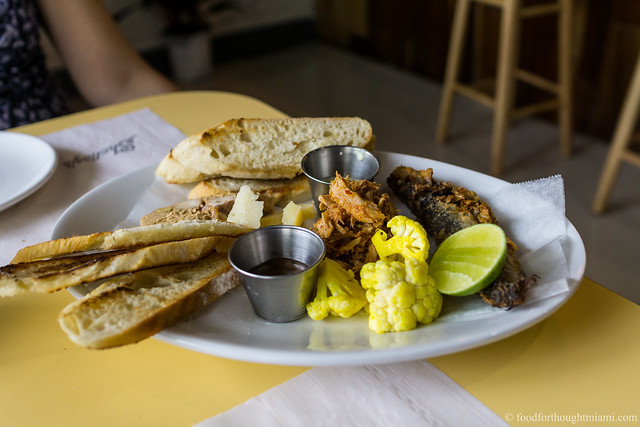 |
| seafood charcuterie platter |
Friday, January 12, 2018
best dishes of 2017: part 3
We left off Part 2 of my "Best Dishes of 2017" (you can see Part 1 here too) in San Francisco. We stay in the Bay Area for Part 3 here, with a trip up to Healdsburg, then detour to Las Vegas, swing back to the east coast for a quick trip to Boston, then back home before ending the year in Santa Fe, New Mexico. As always, the "best" here is meaningless – this is just a compilation of some personal favorites from among several great meals over the course of the year.
Our summer getaway found us on the West Coast, a trip which included a couple days in Healdsburg. The wine country in the northern reaches of Sonoma County is among my favorite places on earth, and now it has a restaurant to match the beauty and bounty of the area: Kyle Connaughton's SingleThread (see more pictures in this SingleThread Farm flickr set). SingleThread is about as fully realized a vision of the Japanese combination of kaiseki dining and ryokan as you'll find outside of Japan: a restaurant, supplied by its own nearby five-acre farm (run by spouse Katina Connaughton) plus contributions from neighboring farmers, fishermen and foragers, with a small, luxurious inn on premises (we regretfully didn’t stay at the inn, instead renting a house up the Russian River so we had room for the whole family and some friends).
This was, from start to finish, just a magical meal – refined and beautiful and flavorful, intimately expressive of season and place.
After a glass of bubbly and a platter of snacks on the rooftop garden terrace, we were brought back inside to the dining room and greeted with a spread that could do double duty as a centerpiece. There’s maybe a dozen different items laid out across the table, interspersed among an arrangement of branches and blooms. I won’t try to recount everything here, and in any event the contents vary from day to day and season to season like the "hassun" course of a kaiseki meal, but I particularly recall the cold slivers of geoduck in a neon peach-hued stone fruit gelee; a tart, bright, green tomato gazpacho; a creamy corn panna cotta with an accent mark of fermented cucumber; silky purple baby eggplant agebitashi with a sesame and plum curd; an intensely rich mousse of potato and salt cod; ripe, fat mulberries from nearby Middlteton Farm. And it's all as delicious as it is beautiful.
From an ornate tapestry of dishes to bare-bones simplicity: wild king salmon, caught in Half Moon Bay, smoked in an ibushi-gin (a type of donabe, or Japanese stone pot, which are something of an obsession at SingleThread), swimming in a vinaigrette of negi (Japanese scallion) bolstered with the magic of shio koji, garnished with a dollop of char roe and a tiara of finely slivered myoga (young ginger) and radish. When I had the smoked salmon at Willows Inn, I was pretty certain that would be the best salmon I'd ever eat in my life. Now I'm not so sure.
So often, foie gras gets fruity accompaniments as a foil for its richness. Here, instead, Connaughton goes vegetal. A disk of poached foie, with a texture like cool butter, is awash in a "tea" of last year's tomatoes, plus an assortment of radishes and their greens in various forms: fresh, preserved, dried. The peppery crunch of the radishes does the same job without the usual cloying sweetness. And then another bit of magic comes from an aged sake poured with it – again, a far cry from the customary sweet Sauternes – which magically pulls it all together, one of the most memorable pairings of the whole year.
I know, we're four deep into this list and we're still haven't left SingleThread. What can I say, it was pretty good. This bowl of Sonoma grains, bound in a luminous green nettle purée, garnished with kasuzuke pickled vegetables, a farro verde beignet, a bouquet of herbs, sprouts and petals from the garden, and a tableside drizzle of an intense aged rib cap jus (presumably a byproduct of the American wagyu served in the prior course), was served as the final savory item on the menu, in the same fashion that a rice dish usually acts as the anchor of a Japanese meal. It was incredibly gratifying and delicious, and felt like something of a summary and recapitulation of all that preceded it.
In October, a conference brought me to Las Vegas, where I always find time to visit Aburiya Raku (read my thoughts and see more pictures in this Aburiya Raku flickr set). It's the first place I tried fresh, house-made tofu and it's still one of my favorite places to order it. The pro move is to go half-and-half: a half order of the "Raku's tofu," served cold with garnishes of katsuobushi, chopped chives, minced ginger, and green tea salt; and a half-order of the agedashi tofu, fried, doused in an enriched dashi broth bobbing with little mushrooms, and topped with a dollop of ikura, shredded nori and more chopped chives. It's so good.
(continued ...)
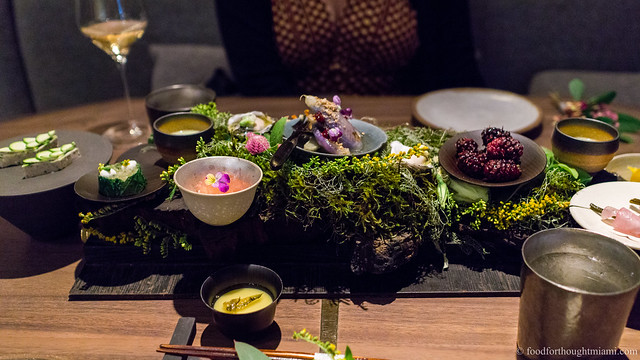 |
| mid summer in Sonoma - SingleThread |
This was, from start to finish, just a magical meal – refined and beautiful and flavorful, intimately expressive of season and place.
After a glass of bubbly and a platter of snacks on the rooftop garden terrace, we were brought back inside to the dining room and greeted with a spread that could do double duty as a centerpiece. There’s maybe a dozen different items laid out across the table, interspersed among an arrangement of branches and blooms. I won’t try to recount everything here, and in any event the contents vary from day to day and season to season like the "hassun" course of a kaiseki meal, but I particularly recall the cold slivers of geoduck in a neon peach-hued stone fruit gelee; a tart, bright, green tomato gazpacho; a creamy corn panna cotta with an accent mark of fermented cucumber; silky purple baby eggplant agebitashi with a sesame and plum curd; an intensely rich mousse of potato and salt cod; ripe, fat mulberries from nearby Middlteton Farm. And it's all as delicious as it is beautiful.
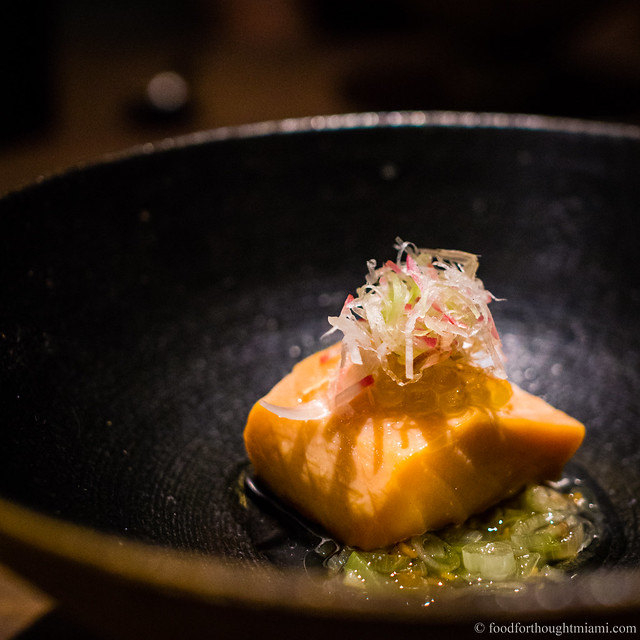 |
| wild king salmon ibushi-gin - SingleThread |
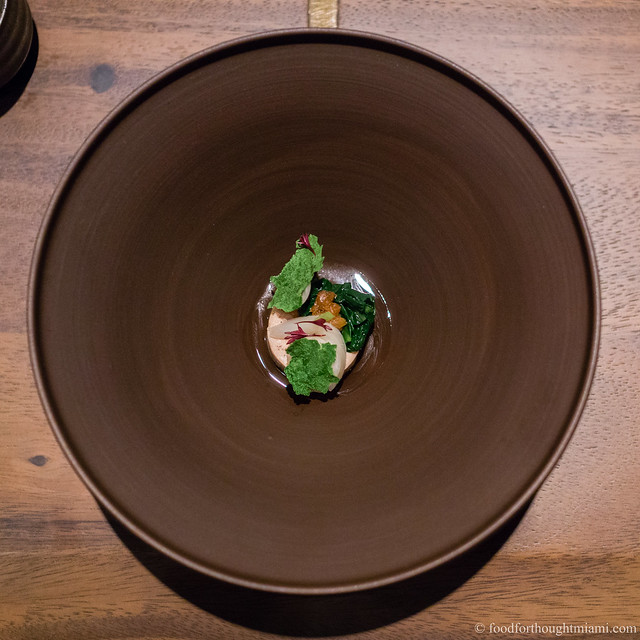 |
| poached foie gras, tea of last year's tomatoes - SingleThread |
 |
| Sonoma grains, nettles, kasuzuke - SingleThread |
 |
| agedashi tofu - Aburiya Raku |
(continued ...)
Monday, January 8, 2018
best dishes of 2017: part 2
We started last Friday with my "best dishes of 2017: part 1" – a compendium of personal favorites from the past year. We resume here with a highly pedigreed fried chicken sandwich, take quick treks through New York and Philadelphia, then detour back to Miami before swinging out to the west coast.
La Pollita was a short-lived Mexican-themed pop-up run from a trailer in the Midtown Garden Center by Luciana Giangrandi and Alex Meyer, who had previously worked at such places as Eleven Madison Park, NoMad, Scarpetta and Animal (read my thoughts and see more pictures in this La Pollita flickr set). The trailer is gone but the duo still seem to be kicking around Miami – I'm looking forward to what's next from them.
They've got a short list of tacos, served on fresh tortillas pressed from masa supplied by Miami masa maestro Steve Santana (of Taquiza), and the cochinita pibil I tried was very good. But the standout item was the fried chicken cemita. A hot, crispy, juicy tranche of fried chicken. A crunchy, vinegar-laced, herb-flecked cabbage slaw. A dollop of mashed avocado for some richness. A creamy, mildly spicy Valentina aioli. A sesame-seed flecked bun with just the right heft: substantial enough to be a meaningful component of the sandwich composition and to keep everything together until the last bite; but not so much as to overwhelm the stars of the show. It is just about perfect.
Hey, look, it's another great meal I never got around to writing about, at David Chang's Momofuku Ko, where the kitchen is run by Sean Gray (see more pictures in this Momofuku Ko flickr set). I never got to the original incarnation of Ko, legendary for its relatively affordable tasting menus, brutally uncomfortable stools, and impossible reservation system. In its newer digs down a tiny East Village street literally called "Extra Place," it retains some of its original punk sensibilities – the dining counter circling an open kitchen, the cooks presenting the dishes, the hip-hop soundtrack – but it's all pretty buffed and polished, kind of like a Gucci biker jacket.
The tasting menu still carries a couple of the original Ko classics – the "Ko egg" with caviar, crispy potatoes, onion soubise and sweet potato vinegar, the shaved frozen foie gras – but one of my favorites of the evening was a next generation Ko dish. It's deceptively simple: lobes of cold, sweet sea urchin, a scoop of chickpea hozon (a creamy, miso-like fermented paste), a drizzle of grassy olive oil. There's a subtle contrast of marine salty-sweet against earthy salty-sweet; of the delicately creamy texture of the uni against the thicker, peanut butter-y hozon, mirrored by the two orange shades on the plate. Pretty cool.
Another of my favorites at Ko was another deceptively simple composition: a dessert of cherry blossom dusted ice cream, served over creamy, sweet amazake (rice fermented with sake lees or koji), drizzled with a sauce of preserved cherries. It was simultaneously delicate but powerful, homey but elegant.
Olmsted, Greg Baxtrom's Brooklyn restaurant with a backyard garden that does double-duty as a pre- and post-meal hangout spot, has been much talked about (see more pictures in this Olmsted flickr set). In a way, all the chatter possibly sets expectations a bit too high, for what is just a really fun, delicious, casual, cozy, clever, relatively affordable neighborhood spot run by someone with chops honed at Alinea, Blue Hill at Stone Barns, Per Se, and Arzak. The menu changes all the time – they were on a yakitori bender during our visit, while also serving Hyderabadi inspired duck chakna, truffle-dusted rutabaga "tagliatelle," and simple but delicious sauteed soft-shell crab with pickled peppers and ranch dressing – but this one dish seems to have become a signature, and for good reason. A goldenrod hued carrot crepe serves as the platform for a salad of wispy slivers of multi-colored carrots, petals, sprouts, and sunflower seeds, concealing a rich clam and carrot stew underneath. It's unusual, unexpected, and delicious.
Daniel Rose's path was a somewhat unusual one. The Chicago native was inspired to move to Lyon to study cooking after taking classes at the American University in Paris. After years at the Institut Bocuse and apprenticeships around France, he opened his first restaurant – Spring – in Paris. It wasn't until a decade later that he returned to the States to open Le Coucou in New York with Stephen Starr (see more pictures in this Le Coucou flickr set). In a way, the place makes it feel like the last couple decades of dining history never happened. There are pressed white tablecloths and long wax tapers on the tables; the menu isn't a collage of small plates, but good old fashioned hors d'oeuvres, poissons et viandes (though a category of "gourmandises" features otherwise uncategorized indulgences like quennelles de brochet and veal tongue with caviar).
But the cooking is more precise, focused, bright and clean than the butter and cream laden juggernauts of the older era that Le Coucou otherwise invokes. And nowhere was that more evident than in a dish called "tout le lapin" (all the rabbit), a production which comes to the table in three different serving vessels (the picture here is better focused, but this one gives a view of the whole spread). The saddle is rolled and cooked and then sliced into rounds which are seared and browned, then napped with a loose sauce that takes the ferrous richness of rabbit offal, cuts it with an acidic vinaigrette, and brightens it with fresh mint. Alongside is a gratin dish of the rabbit's legs cooked down with soft, sweet onions. And finally, a pot au feu of the foreleg, in a golden broth bobbing with carrots and turnips. It's all wonderful.
(continued ...)
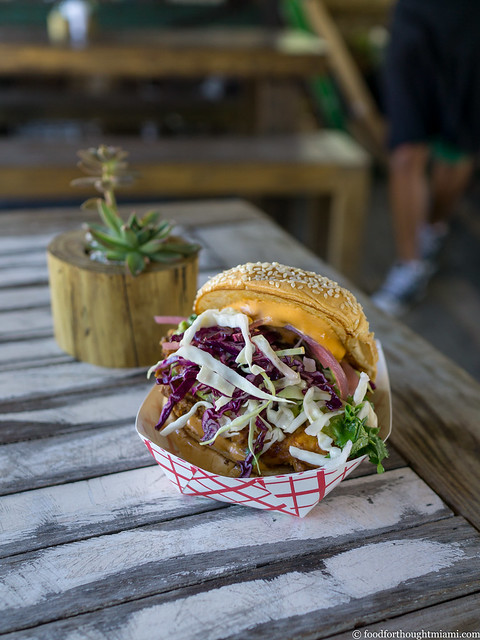 |
| fried chicken cemita - La Pollita |
They've got a short list of tacos, served on fresh tortillas pressed from masa supplied by Miami masa maestro Steve Santana (of Taquiza), and the cochinita pibil I tried was very good. But the standout item was the fried chicken cemita. A hot, crispy, juicy tranche of fried chicken. A crunchy, vinegar-laced, herb-flecked cabbage slaw. A dollop of mashed avocado for some richness. A creamy, mildly spicy Valentina aioli. A sesame-seed flecked bun with just the right heft: substantial enough to be a meaningful component of the sandwich composition and to keep everything together until the last bite; but not so much as to overwhelm the stars of the show. It is just about perfect.
 |
| sea urchin, chickpea hozon - Momofuku Ko |
The tasting menu still carries a couple of the original Ko classics – the "Ko egg" with caviar, crispy potatoes, onion soubise and sweet potato vinegar, the shaved frozen foie gras – but one of my favorites of the evening was a next generation Ko dish. It's deceptively simple: lobes of cold, sweet sea urchin, a scoop of chickpea hozon (a creamy, miso-like fermented paste), a drizzle of grassy olive oil. There's a subtle contrast of marine salty-sweet against earthy salty-sweet; of the delicately creamy texture of the uni against the thicker, peanut butter-y hozon, mirrored by the two orange shades on the plate. Pretty cool.
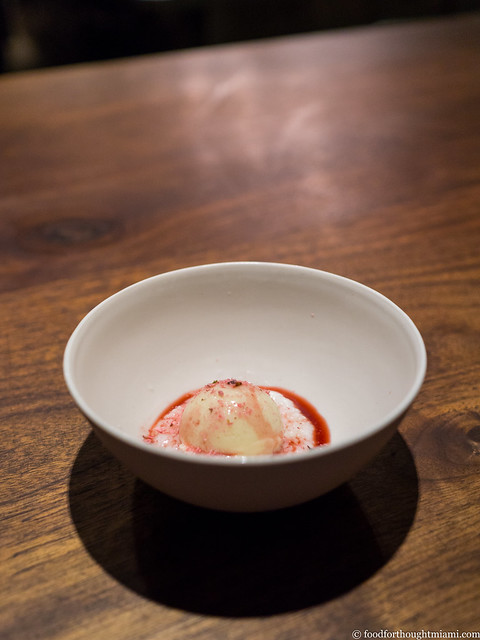 |
| cherry blossom, amazake - Momofuku Ko |
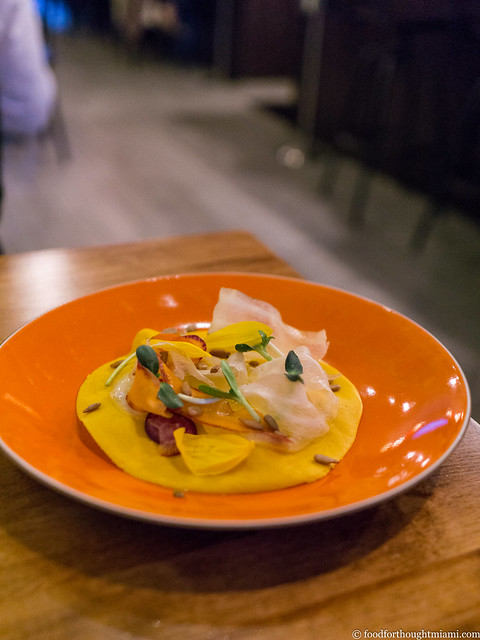 |
| carrot crepe, littleneck clam, sunflower - Olmsted |
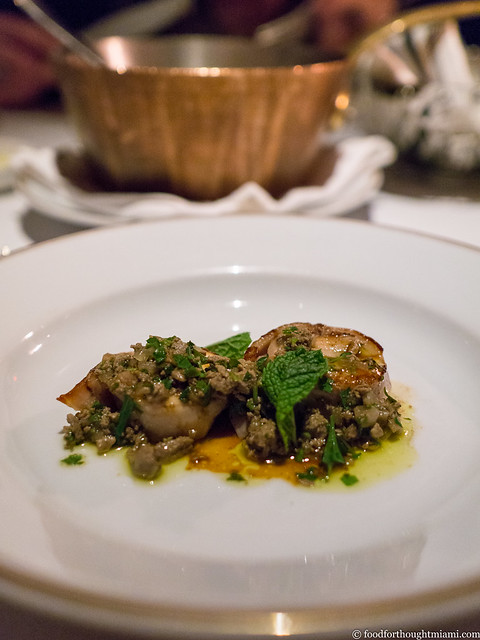 |
| tout le lapin - Le Coucou |
But the cooking is more precise, focused, bright and clean than the butter and cream laden juggernauts of the older era that Le Coucou otherwise invokes. And nowhere was that more evident than in a dish called "tout le lapin" (all the rabbit), a production which comes to the table in three different serving vessels (the picture here is better focused, but this one gives a view of the whole spread). The saddle is rolled and cooked and then sliced into rounds which are seared and browned, then napped with a loose sauce that takes the ferrous richness of rabbit offal, cuts it with an acidic vinaigrette, and brightens it with fresh mint. Alongside is a gratin dish of the rabbit's legs cooked down with soft, sweet onions. And finally, a pot au feu of the foreleg, in a golden broth bobbing with carrots and turnips. It's all wonderful.
(continued ...)
Subscribe to:
Comments (Atom)



